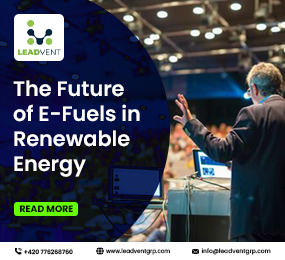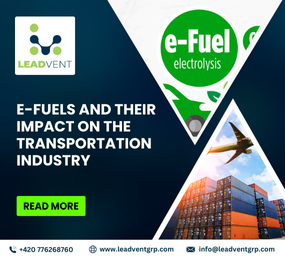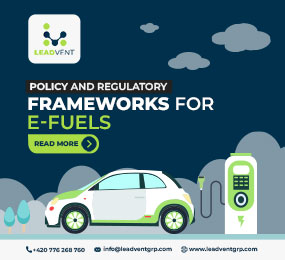In a world that is gradually moving towards a net-zero carbon policy, it appears to be extremely vital to cut down the emissions and to embrace something alternative to enhance the efficiency of the operation. Here in this scenario, the E-fuels or electrofuels come in handy and they take part in endowing the transport system with utmost sustainability which is hardly possible with the help of the fossil-fuel reinforced system. E-fuels are touted as the carbon-neutral solution that aids in operating the hard-to-abate sectors with ease. World E-Fuels Summit, 2024 as a premier global event is going to solemnise an insightful discussion related to regulatory practices, market dynamics and the financial mechanisms.
E-fuels are created with the usage of hydrogen and electrolysis of water, while it aids in improving the pace of the operational procedure of the industries. In this blog, we are going to delve deep into the mechanics of e-fuels and their compatibility with the current internal combustion engine. Let’s get into this blog to unearth more insights regarding e-fuels or alternative fuels.
E-Fuel- a Drop-in Solution for the Transport System
As the world has started to grapple with the urgent need for sustainable energy solutions, e-fuels are emerging as a compelling contender in the race to decarbonize transportation. In the transportation industry, the E-Fuels are a new reality and it is preparing the whole sector for a decarbonised future. The focal point of this blog is to come up with pertinent information regarding the e-fuels as alternative fuels along with their benefits.
Benefits of E-fuels
Positive impact on the environment
E-fuels are widely accepted all over the globe due to their climate-neutral property. In addition to that, the closed-loop cycle of production contributes to the reduction of greenhouse gas emissions and it also aids in waging war against climatic alterations.
Versatility across different modes of transport
Forget about the compatibility issues of the fuels as e-fuels are suitable for all types of vehicles, including passenger cars, trucks, ships, and airplanes. This feature of the e-fuels makes them an attractive option for every transport sector. On the other hand, the segments of transportation that require high energy density and are difficult to electrify, such as aviation and long-haul trucking also reap its advantages in the long term.
Energy storage and transport
E-fuels can be used for transporting over long distances with minimal energy loss. This capability addresses one of the major challenges related to renewable energy. The lurking risk of energy depletion will no longer plague the sector of transportation due to the dominant presence of e-fuels that have the motive of decarbonization.
Integration of E-fuel into Public Transit Systems
As per the statistical records, the global e-fuel market is predicted to grow from USD 6.2 billion in 2023 to USD 49.4 billion by 2030. From this data, we can assume this alternative fuel is likely to take charge of the entire transport industry in the upcoming years, although it is also fraught with a few severe challenges that appear during the time of scaling of its production.
Public transport like buses, trucks or other vehicles are held accountable all the time for spiking the rate of pollution and global warming as a dire consequence of it. E-fuels as the viable alternative to conventional fuels are transforming the public transportation sector, while also maintaining the standard of operational efficiency.
Case Studies
To assess and evaluate the potential of E-fuel and its capability of integration, here we are going to highlight real-life scenarios.
BMW's Partnership with Vattenfall
BMW since 2014 has been venturing into the arena of e-fuels and has teamed up with the eminent Swedish energy company, Vattenfall to produce synthetic fuels with the deft use of renewable energy sources. This collaboration focuses on creating a sustainable fuel option that can be utilised in existing combustion engines. It is also reducing emissions without requiring a complete overhaul of current vehicle fleets. BMW’s endeavour of the inclusion of e-fuels in Europe’s CO2 regulations, emphasises their potential role in decarbonization of the transport sector as a whole.
Sunfire GmbH's Power-to-Liquid Technology
Sunfire GmbH as a pioneer of Power-to-Liquid technology is continuing to convert renewable electricity into liquid hydrocarbons. It is in reality serving as e-fuels. Their pilot projects have their focus on producing synthetic fuels, especially for sectors like aviation and shipping, which are particularly challenging to electrify. With this innovative initiative, Sunfire GmbH has grabbed the leading position in the e-fuel market.
FAQs
1) What are the main advantages of using e-fuels in road transport?
Key advantages of e-fuels include compatibility with existing vehicles and infrastructure. On the other hand, it plays a vital role in decarbonization of the hard-to-abate sectors.
2) How do e-fuels impact emissions compared to conventional fuels?
E-fuels can offer significant emissions reductions compared to fossil fuels during the time of its production.
3) Where are e-fuels best suited for use in transportation?
E-fuels are best suited for the hard-to-abate sectors like aviation, shipping and long haul transport like trucks that are too difficult to electrify.
Final Thoughts
The integration of e-fuels into public transit systems is not merely a trend, but also it can be considered as the initial step towards a sustainable future. Investing in cutting-edge technologies, now, the market leaders and the policymakers can aid in making the transport sector entirely free from emissions.
World E-Fuels Summit, 2024 is going to bring out more ideas and innovative insights regarding the e-fuels that will pave the path for a greener tomorrow. To become a part of such grand events and to know more about alternative fuels, connect with Leadvent Group.












